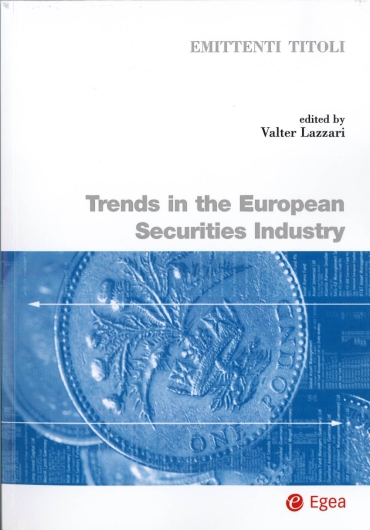| PREFACE | IX |
| INTRODUCTION | XI |
| Ch.1 GOING PUBLIC AND LISTING FEES AROUND THE WORLD - Manuela Geranio and Valter Lazzari | 1 |
| 1 Introduction | 1 |
| 2 Becoming a Public Company: What Does It Mean Nowadays? | 5 |
| 2.1 Going and Being Public in an EU Regulated Market | 5 |
| 2.2 Going and Being Public in a Self Regulated Market | 6 |
| 2.3 Going and Being Public in Non-EU Jurisdictions | 9 |
| 3 Listing Services | 12 |
| 4 Admission Fees: Rationale and Structure | 14 |
| 4.1 Fec Floorand Cap | 19 |
| 4.2 A Comprehensive Comparison | 23 |
| 5 Annual Fee: Rationale and Structure | 27 |
| 5.1 Fee Floor and Cap | 27 |
| 5.2 A Comprehensive Comparison | 30 |
| 5.3 Annual Listing Costs: the BIT Case | 32 |
| 6 Fee Comparison over Time | 36 |
| 7 Admission and Annual Fees in Self Regulated Markets | 37 |
| 8 Listing Fees for Corporate Bonds and Warrants | 40 |
| 9 Exchange Fees for Further Corporate Actions | 41 |
| 10 Regulatory Fee Due to the Authority | 42 |
| 11 Conclusions | 47 |
| References | 49 |
| Ch.2 AN ASSESSMENT OF THE QUALITY OF LISTING SERVICES: THE ITALIAN CASE - Valter Lazzari and Giovanna Zanotti | 51 |
| 1 Introduction 51 |
| 2 The Design of the Experiment | 53 |
| 3 The Description of the Sample | 55 |
| 4 The Support in Fulfilling the Reporting Obligations | 58 |
| 5 The Support for Corporate Actions | 63 |
| 6 The Educational Services | 67 |
| 7 The "investor Relations" Service | 70 |
| 8 Ancillary Services | 73 |
| 9 The Costs of Being Public | 75 |
| 10 The Financial Supervisory Authority | 77 |
| 10.1 The Quality of the Interaction | 77 |
| 10.2 The Costs of the Domestic Financial Service Authority | 80 |
| 11 The Overall Costs of Being Listed | 82 |
| 12 Conclusions | 87 |
| References | 88 |
| Ch.3 THE EMERGING LANDSCAPE IN EUROPEAN SECURITIES TRADING - PeTer Gomber and Marus Gsell | 89 |
| 1 Introduction | 89 |
| 2 Requirements on Capital Markets: The issuers Perspective | 90 |
| 2.1 Market Integrity | 91 |
| 2.1.1 Fairness of Markets | 92 |
| 2.1.2 Efficient and Correct Valuation | 92 |
| 2.1.3 Regulatory Responsibility | 93 |
| 2.2 Market Quality | 93 |
| 2.2.1 Liquidity | 94 |
| 2.2.2 Volatility | 94 |
| 2.3 Visibility | 94 |
| 3 Regulatory Changes to the European Securities Trading Landspe | 95 |
| 3.1 The Trading Landscape Before MiFID | 95 |
| 3.2 MiFID: The New Regulatory Framework in Europe | 96 |
| 3.2.1 New Market Venues | 97 |
| 3.2.2 Pre- and Post-Trade Transparency | 99 |
| 3.2.3 Best Execution | 101 |
| 3.3 MiFID vs. RegNMS: A Comparison of EU and US Regulation | 102 |
| 3.3.1 Market Venues: MTFs vs. ECNs | 102 |
| 3.3.2 Best Execution: EU Pre-Trade Transparency vs. US Trade-Through Rule | 103 |
| 3.3.3 Market Data: EU Post-Trade Transparency vs. US Consolidated Tape | 104 |
| 4 MiFIDs Implications for Trading | 104 |
| 4.1 Market Models | 105 |
| 4.1.1 Regulated Marketsand MTFs | 105 |
| 4.1.2 Internalisation: Systematic lnternalisers | 109 |
| 4.1.3 Block Trading: Crossing Networks / Dark Pools | 110 |
| 4.2 Market Fragmentation | 112 |
| 4.3 Market Data | 117 |
| 4.3.1 Pre-Trade Market Data | 118 |
| 4.3.2 Post-Trade Market Data | 118 |
| 4.4 MiFID Review 20l0 | 119 |
| 5 Conclusion I Policy Implications for Issuers | 120 |
| References | 121 |
| Ch. 4 THE FRAGMENTATION OF THE EUROPEAN EQUITY MARKRT - Stephen Grob | 127 |
| 1 Introduction 127 |
| 2 MiFID in a Global Context: Rules vs. Principles Based Regulation | 128 |
| 3 The impact of MiFID | 130 |
| 4 Increased Competition: Fragmentation across Lit Venues | 132 |
| 4.1 New Venues versus Established Exchanges | 138 |
| 5 Increased Competition: Fragmentaon across Lit and Non-Lit Venues | 142 |


